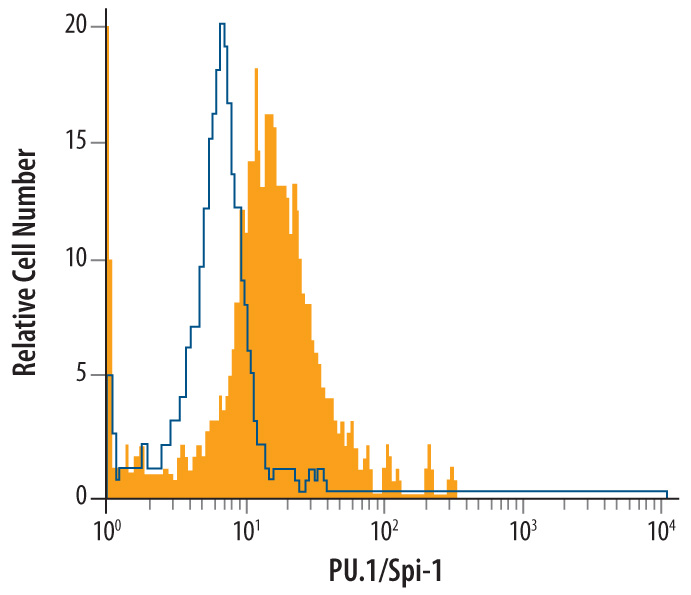Human PU.1/Spi-1 Antibody Summary
Met1-Lys169
Accession # NP_001074016
Applications
Please Note: Optimal dilutions should be determined by each laboratory for each application. General Protocols are available in the Technical Information section on our website.
Scientific Data
 View Larger
View Larger
Detection of Human PU.1/Spi‑1 by Western Blot. Western blot shows lysates of K562 human chronic myelogenous leukemia cell line and Daudi human Burkitt's lymphoma cell line. PVDF membrane was probed with 2 µg/mL of Mouse Anti-Human PU.1/Spi-1 Monoclonal Antibody (Catalog # MAB5870) followed by HRP-conjugated Anti-Mouse IgG Secondary Antibody (Catalog # HAF007). A specific band was detected for PU.1/Spi-1 at approximately 40 kDa (as indicated). This experiment was conducted under reducing conditions and using Immunoblot Buffer Group 1.
 View Larger
View Larger
Detection of PU.1/Spi‑1 in THP‑1 Human Cell Line by Flow Cytometry. THP-1 human acute monocytic leukemia cell line was stained with Mouse Anti-Human PU.1/Spi-1 Monoclonal Antibody (Catalog # MAB5870, filled histogram) or isotype control antibody (Catalog # MAB004, open histogram), followed by Phycoerythrin-conjugated Anti-Mouse IgG Secondary Antibody (Catalog # F0102B). To facilitate intracellular staining, cells were fixed with paraformaldehyde and permeabilized with saponin.
Reconstitution Calculator
Preparation and Storage
- 12 months from date of receipt, -20 to -70 °C as supplied.
- 1 month, 2 to 8 °C under sterile conditions after reconstitution.
- 6 months, -20 to -70 °C under sterile conditions after reconstitution.
Background: PU.1/Spi-1
PU.1 (Purine-rich nucleic acid binding protein 1; also 31 kDa transforming protein and SPI-1) is a member of the PU subfamily, ETS family of transcription factors. Although its predicted MW is 31 kDa, it appears to run anomalously high in SDS-PAGE at 40‑45 kDa. PU.1 is a monomeric hematopoietic protein that regulates the differentiation of early myeloid and lymphoid progenitors. High PU.1 levels favor granulocyte and macrophage production, while low levels generate magakaryocytes, erythrocytes, T and B cells. Human PU.1 is 270 amino acids (aa) in length. It contains an N-terminal acidic/polyGln transactivation region (aa 34‑99), a non‑destabilizing PEST sequence (aa 117‑165) and a C-terminal Ets DNA-binding domain (aa 170‑253). PU.1 is phosphorylated on Ser146, allowing it to bind to Pip. Over aa 1‑169, human PU.1 shares 88% aa identity with mouse PU.1.
Product Datasheets
FAQs
No product specific FAQs exist for this product, however you may
View all Antibody FAQsReviews for Human PU.1/Spi-1 Antibody
There are currently no reviews for this product. Be the first to review Human PU.1/Spi-1 Antibody and earn rewards!
Have you used Human PU.1/Spi-1 Antibody?
Submit a review and receive an Amazon gift card.
$25/€18/£15/$25CAN/¥75 Yuan/¥1250 Yen for a review with an image
$10/€7/£6/$10 CAD/¥70 Yuan/¥1110 Yen for a review without an image




